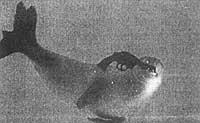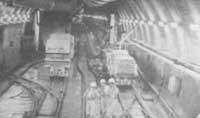Exploring the building and the rear of the Aquarium of San Sebastián
1998/12/01 Elhuyar Zientzia Iturria: Elhuyar aldizkaria
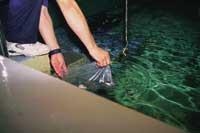
New Home Home New Home
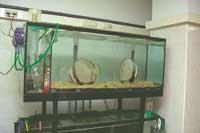
In the exhibitors of the new Aquarium you can see the fish in a resplendent way, then dark and agitated. However, before you get to this point you have to work a lot. The first thing to do is capture fish. Fish caught in the sea need more time and more value than they expected to adapt to their new home, so before going out to the public they have to spend a season of air conditioning.
In the Aquarium there are three zones of atmosphere for the fish to spend the quarantine: two for the new Aquarium and another for the old one. Along with the newly arrived fish, those who get sick are taken to a quarantine, next to the laboratory, for more precise surveillance. In the same way, tropical fish are forced to perform quarantine next to the laboratory, since for them, with a more demanding change, they need more precise monitoring. Therefore, there are two quarantine, one oriented to conditioning and another related to the follow-up and curative treatment of slow fish.
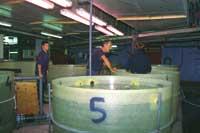
Most diseases are due to parasites and a curative treatment based on the cave is applied to them. The new fish, in quarantine, are also treated to avoid parasites. For the fish to be well, it is very important that the water is well. For this reason, a daily analysis of the water of each exhibitor and a follow-up of the fish that arrive or are sick. All this is done in the laboratory, taking water from each exhibitor, checking the amount of oxygen necessary, measuring salinity and pH, as well as concentrations of ammonium, nitrite and nitrates, and checking if the water is at the proper temperature. The water that enters the exhibitors is also analyzed.
Clean water, living water
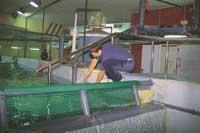
The water that enters the Aquarium is taken from the sea, but before reaching the exhibitors, in addition to the usual studies, it has to travel a long way. The filters and piping systems play a fundamental role in the Aquarium, since in case of failure, the water would get dirty and the system would deteriorate entirely with the danger of killing fish. Therefore, all purification and protection systems are duplicated forming a labyrinth of pipes, filters, pumps and cleaning tools.
To guarantee the quality of the water, the water received from the outside is purified. The first treatment is decanting to remove the sand that has entered along with water. Then, the water is mixed with oxygen by agitators to be introduced in biological filters. Here, by bacteria, the biodegradation of the organic matter present in water is produced. Subsequently, through the passage of water by decanting tanks, the degraded organic matter is separated from water by decanting. Ultraviolet radiation is also used to remove possible pathogens present in water.
Keeping clean the water that arrives clean is also fundamental for its proper functioning. Every day 10% of the water is renewed, that is, this amount of water from the sea is collected through absorbent pumps and sent through a pump so many “old” waters outside. After the cleaning process, of course.
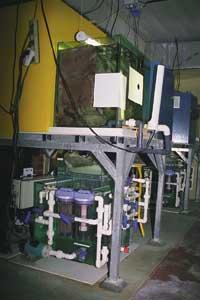
In addition to changing water, they have to have everything in clean water. This is a work of the divers: put with the vacuum cleaners and remove the organic material so that then enter the ozone chamber so that it is clean before leaving; clean the structure of methacrylate so that it does not appear cracked with much care.
Like cleaning, the water temperature has a lot to do with the fish tank. Also installed in the Aquarium the necessary machinery for the water to be about 20ºC. For the moment (mid-October) it has not been used to heat, since that of the sea is hotter than this, and they will have to start it in winter.
With the presence of so many tubes and filters, maintenance is also important. The engines, the problems that are generated in the filters… are common. Most of the problems occur in the Aquarium due to the rough and bad sea, which mainly affects filters. In these cases the introduction of dirt in the filters is something common until the closure of the passage of water. When this occurs, filters must be released and cleaned. In addition, most of the maintenance is due to engine or pressure problems.
Safe daily food safe
The last work that the visitor does not see would be that of feeding the fish. Every day, 22 kilos of food are distributed to the fish in the morning and in the afternoon. Store the food in a giant freezer. 24 hours before giving the fish passes to a refrigerator to be softened slowly. From there it leaves and prepares because not all fish eat the same thing.
The Aquarium has about 5,000 fish. In view of this, it does not seem that they are given too much to eat. The locals say that it is enough, even in the sea, when they are free, because the fish do not eat daily.
How have you worked?
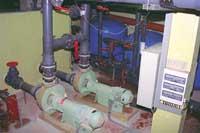
First we made the structure project. This project envisaged the drilling of the Paseo Nuevo and the construction of concrete walls on Mount Urgull and the coast. We excavate the last 120 meters of the Paseo Nuevo, with an average width of 15 meters and a depth of 8 meters. Before starting drilling, we conducted a geotechnical study with five surveys. Thanks to this, we found rocks of sandstone and limestone of high resistance. From there the work began.
The work has been done in 2 years. First we dig the plot with 24,000 m3 of sand. At first we brought conventional mechanical tools, but since the plot was narrow and could not work, it was decided to make small controlled explosions. The function of small explosions was to perform fissures in the rock for its subsequent extraction by conventional mechanical tools. Once this was done, the entire plot was perforated and a rock and gravel crusher was installed. Every day, 100 trucks full of gravel were released and then sold and covered the drilling process. We spent about 5 months in drilling.
Why couldn't conventional mechanical appliances work?
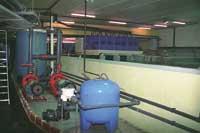
The lot was narrow and we also had the sea on one side and Mount Urgull on the other. The drilling began through the port and back towards the Paseo Nuevo. There it was impossible to put giant cranes, because the arms touched Mount Urgull; we had to use mobile cranes with wheels, which made it difficult to work, since being a narrow lot of coordination was needed.
Painting the plot…
After drilling, we began to realize the walls of the most deteriorated environment. The coast wall, deteriorated in many sections, was reinforced with concrete to make it stand. Then we made Mount Urgull, without problems, since the very layer of the rock is oriented towards the interior. So we could cut it perfectly clean and correctly.
Did they have problems with the sea in this phase?
No. Part of the coastal wall was built on the rock, but as we had to go down below, we had to remove the rock and make a new stretch of coastal wall. That was something special. In addition, we had to install a sea water outlet with a deep pump system. When we were in it, yes, the water was coming in there, but as it entered it went out.
Did they make the structure by phases?
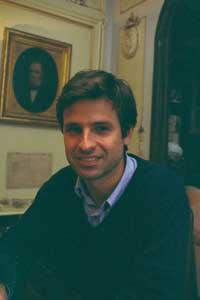
Yes. We start with the concrete bases supporting on the rock the pillars of the structure. It was proceeded to the foundation of the section closest to the port, then the columns and beams of concrete realized in the same one were placed, and finally they were placed on them plates of 6 tons of 12 meters long and 40 centimeters wide. The placement of these plates forced us to suddenly bring huge cranes of 150 tons and 30 meters of arms, covering about 200 square meters daily. Once this was done, we could advance between 25 and 30 meters, taking another section of the building and retaking the process. Thus, by the time the structure was made in the first part, in the second part we were doing the structure, and perhaps in the third part we were drilling.
Has the Aquarium had peculiarities in this structural phase?
The work of the tubes has been very special, since many tubes were needed so that those who would then install the filtration system would find everything to measure. The deep taps, surface sockets, lighteners, etc. Of each container, the formwork of the windows was made to millimeter, since the acrylic materials do not admit the least defect, then can produce reflections, all the tubes required to millimeter… there were many things and all had importance. In normal housing, the worker knows what to leave for his future, but the Aquarium is not done every day and you have to control everything.
Would you then start with the facilities?
Then we started to manufacture partitions, ceilings, etc. The assembly of methacrylate tunnels has been the most important work. From Japan they brought them by boat to Bilbao and from there by truck. We spent 6 to 7 days at the location of the tunnels, a piece of the day. As if it were a meccan we had to make a plane of how to place each piece. Everyone was nervous during those days, because if the acrylic material was damaged, in addition to the economic value, we would be greatly delayed. Acrylic is a resistant material, but at the same time fragile, that does not support blows. The acrylic has a resistance of 1,100 kilos per square meter, almost the same as steel. As the material is hot cast, you can get all kinds of shapes with acrylics.
Were they nervous when filling the water exhibitors?
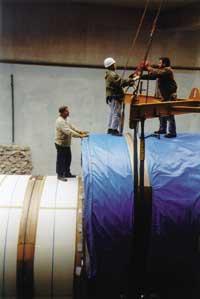
To fill the great exhibitor it took between 6 and 7 days, using two pumps 24 hours a day. The worst moment was that of the arrival of water at the top of the 360º tunnel, where the water pressure is greater. Despite being joined by two large beams, the tunnel is a tube full of air that, by increasing the pressure, tends to go on the water. The union of both beams with the tunnel was a precise work, supported from above with cranes and below with a track based on hydraulic cats. We placed them to millimeter and relaxed. We needed to fill with water and there the problem was that there was no possibility of testing, since to begin to fill with water the exhibitors had to have finished all the decoration topics. Therefore, there was no turning back.
But is the project yours or the Australian? Because, as has been said in the media, one can think that it has been that of the Australians.
Two different tasks have been carried out, on the one hand the structure and the work of operation and, on the other, the aquariology. The latter, the project of fish zones, filters, etc., is that of the Australians, although then we have built it. Hence, the mixture has been produced, since with it the structure and the operation project, which is the one we have carried out, has also been carried out.

Gai honi buruzko eduki gehiago
Elhuyarrek garatutako teknologia




